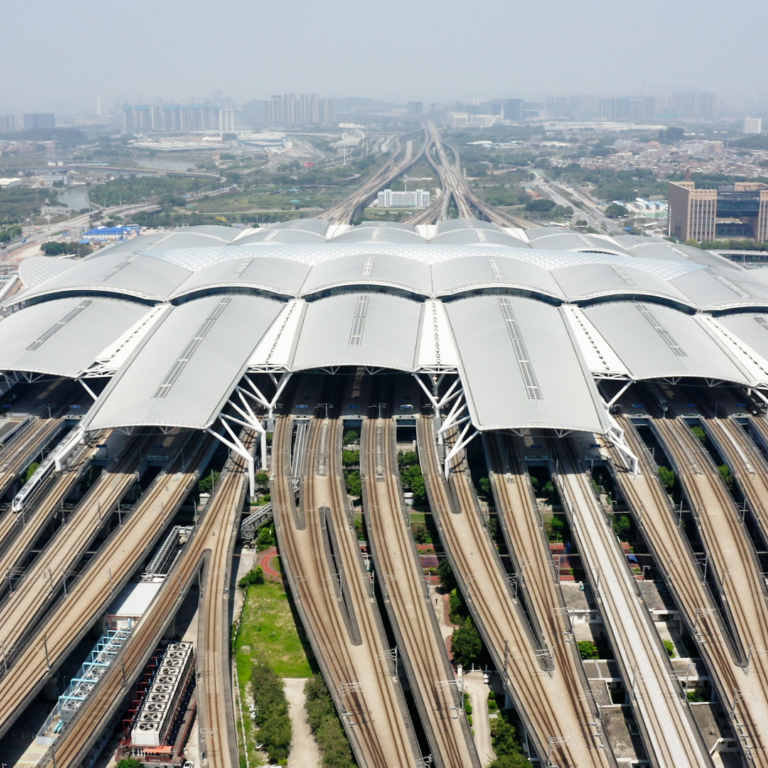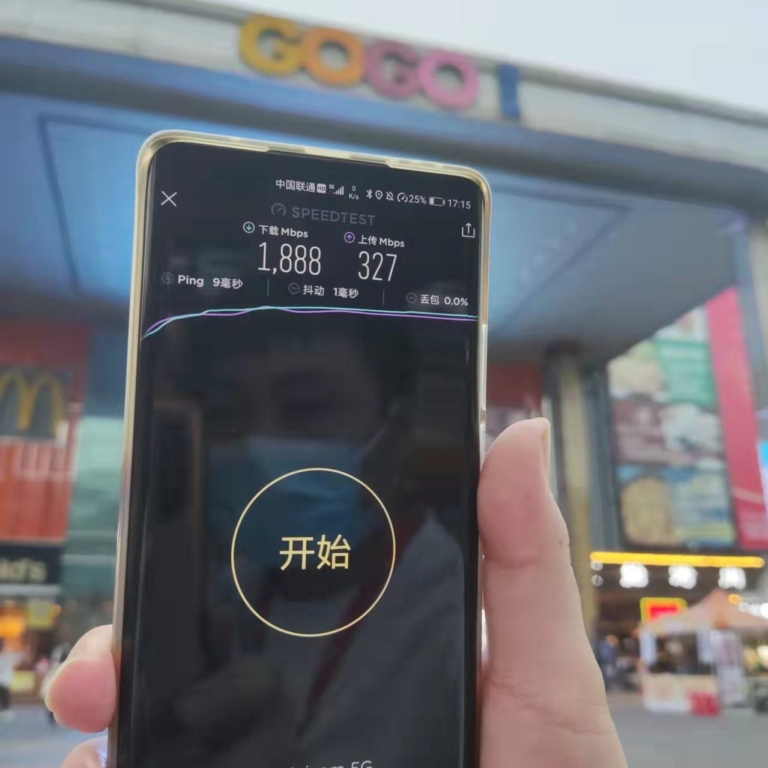5G Transformation Hub
5G Brings Crucial Capacity to Mega Cities
China Unicom Guangdong and Huawei are using new 5G network technologies to enhance Guangzhou's economic and social well-being.
As part of its U-Joy Cities programme, launched in May 2022, Unicom is making large scale commercial use of sophisticated 5G technologies, such as Huawei’s 5G MetaAAU system, carrier aggregation and distributed massive MIMO, to deliver gigabit throughput connectivity and boost network capacity.
Select a project
Contents
Challenge
With more than 18 million residents, Guangzhou is the core hub city in the Greater Bay Area of Guangdong, Hong Kong and Macao. The city is also a major transport hub and hosts hundreds of thousands of students. Guangzhou’s citizens and visitors need access to high definition digital services, but in residential areas of the city, 5G coverage is impaired by the narrow streets, dense buildings, and difficulty in obtaining site locations.
Solution
China Unicom Guangdong and Huawei have deployed Huawei’s 5G MetaAAU (64T64R) solution to enable in-depth 5G coverage in residential areas in Guangzhou. The two companies have also rolled out 5G dual carrier technology in the main urban areas of Guangzhou, Shenzhen, and Foshan to double the network capacity. To improve 5G services in transport hubs, China Unicom Guangdong and Huawei are deploying 5G distributed massive-MIMO technology to effectively resolve interference among 5G cells
Impact & Statistics
In field tests, the 5G MetaAAU system increased cell coverage by 30% on average, while improving the indoor uplink throughput by up to 39% and the downlink throughput up to 38% in high-rise buildings, according to Huawei. The equipment maker also says that distributed M-MIMO has increased the number of 5G connected users by 2.1 times, 5G service volume by 2.4 times and the 5G user experience rate by 2.9 times in areas covered by the new technology.
Wider Implications
The advanced technologies being deployed in Guangzhou demonstrate how 5G can meet the needs of densely-populated cities and transport hubs. China Unicom Guangdong has now built more than 35,000 5G base stations in Guangzhou, achieving comprehensive and “ultra fast” 5G coverage in core urban areas. In 2022, the operator is planning to add 10,000 new sites in Guangzhou, a year-on-year increase of 40%. There will also be 1,610 “new gigabit residential quarters”, a year-on-year increase of 28%, Unicom says.
Stakeholders
Guangzhou Municipal People's Government, China Unicom Guangdong Branch, Huawei
02
5G Brings Crucial Capacity to Mega Cities
China Unicom uses new 5G technologies to bring gigabit speeds to densely populated Guangzhou
With more than 18 million residents, Guangzhou is the core hub city in the Greater Bay Area of Guangdong, Hong Kong and Macao. Dating from 214 BC, the city has seen rapid development in recent decades and a proliferation of super-high-rise residential buildings. Guangzhou’s citizens and visitors want access to HD video, online games, and other demanding digital services, but in many residential areas of the city, 5G coverage is impaired by the narrow streets, dense buildings, and difficulty in obtaining site locations.
As a major transportation hub and university town, Guangzhou also needs excellent 5G coverage on its rail and metro networks, and on its educational campuses.
To meet this demand, China Unicom Guangdong and Huawei are harnessing cutting edge 5G technologies. In densely populated residential areas, the two companies are looking to take full advantage of the large bandwidth of the 3.5 GHz frequency band by rolling out Huawei’s 5G MetaAAU (64T64R) solution. By employing ELAA (extreme large antenna array) and an ultra-high-resolution beam management, the 5G MetaAAU solution enables narrower 5G channel beams. That means the antenna can point at users more precisely, achieve high resolution and reduce interference very efficiently, according to Huawei.
“Field test results showed that 5G MetaAAU (64T64R) can transmit 5G signals further than traditional modules and increase cell coverage by 30% on average,” says Daozhou Xu, Vice President of the 5G and LTE TDD Product Line of Huawei. “5G signals can be further penetrated, improving indoor uplink experience by 26% to 39% and downlink experience by 23% to 38% in high-rise buildings.”
Since it was deployed in August 2022, 5G MetaAAU has been enabling in-depth 5G coverage in residential areas in Guangzhou and maximising the value of 5G macro base stations in these districts, according to China Unicom.
At the same time, China Unicom Guangdong and Huawei have rolled out 5G dual carrier technology in the main urban areas of Guangzhou, Shenzhen, and Foshan – major cities in the Greater Bay Area. “The commercial application of the 5G dual carriers solution in large scale has successfully doubled the 5G experience rate and the 5G system capacity and further consolidates the network foundation for 5G ubiquitous gigabit user experience,” says Daozhou Xu. “Field test results showed that the daily 5G traffic increases by 26% in the dual carrier capacity expansion area in Guangzhou. In hotspot areas such as university campus and industry parks, the stimulation of 5G traffic is more obvious.”

03
Serving the traffic surge during festivals
To improve 5G services in transport hubs, China Unicom Guangdong and Huawei are deploying innovative 5G distributed massive-MIMO technology. The largest of these hubs is Guangzhou South Railway Station, which is the busiest high-speed railway station in southern China. It served 15.5 million passengers during the 2022 Spring Festival, up 10% year-on-year, with a daily average of about 388,000 passengers. The departure hall of South Railway Station is a massive indoor space, making network deployment complex, as interference can occur among multiple 5G cells.
Huawei says the 5G distributed massive MIMO technology is able to effectively resolve this interference. “The field test results showed that after distributed M-MIMO is enabled, the downlink peak data rate of users increases by more than 80%,” explains Daozhou Xu. “Thanks to network expansion and new solutions, the number of 5G connected users increased by 2.1 times and service volume increased by 2.4 times compared with the same period last year. In addition, the 5G user experience rate increased by 2.9 times, effectively meeting customers' requirements for 5G HD video calls, online games, and video on demand.”
China Unicom Guangdong and Huawei have now introduced 5G distributed massive-MIMO at multiple transportation hubs in Guangzhou, including both conventional railway stations and subways. The city’s subway is an important means of transportation for ordinary people. During the 2022 Spring Festival, Guangzhou Metro had an average daily passenger flow of about 7.5 million people.
To address the connectivity needs of so many commuters, China Unicom Guangdong has enabled the 5G distributed M-MIMO feature on Guangzhou Metro Line 18. It says the downlink peak rate of a single user can now reach 1.39 Gbps, while the average user-perceived rate exceeds 1 Gbps in the platform and hall areas, “providing an ubiquitous gigabit experience for passengers.”


Daozhou Xu
Vice President of the 5G and LTE TDD Product Line of Huawei
04
Private networks to serve students and teaching staff
To serve the hundreds of thousands students in Guangzhou, China Unicom Guangdong and Huawei are deploying private networks on the city’s campuses. Located next to the former site of the famous Huangpu Military Academy, Guangzhou University Town and Guangzhou International Biological Island hosts 200,000 college students.
China Unicom Guangdong and Huawei have built “China's first provincial-level 5G smart education private network” in Guangdong, enabling rapid deployment for 168 universities and colleges in Guangdong by sharing resources with the Guangdong Education and Science Network. Students can use smartphones to directly visit the intranet, access academic resources, video conferences and mobile office applications, without having to perform any interim steps.
The private network is designed to support “smart teaching, smart stadiums, smart labs, and big data platforms” on campus, as well as enabling smooth and immersive online teaching during the pandemic. “Thanks to uplink classifier (ULCL) technology, students and teaching staff users can use their mobile phones to access the campus network with a better user experience than with a legacy VPN, and can move seamlessly between the Internet and the campus intranet in an efficient, convenient and secure way,” adds Guixin Pan, Deputy General Manager of Network Product Innovation Center of China Unicom Guangdong.
The ULCL technology steers internal traffic directly to the university network, physically isolating the traffic from the public Internet. Located on an edge user plane function (UPF) within a 5G core network, the ULCL system enables a single cloud server to direct traffic to either the public Internet or a private intranet, enabling devices to employ the same SIM card for both purposes.

05
Meeting the connectivity needs of the Greater Bay area
The latest round of 5G deployments in Guangzhou are part of the U-Joy Cities programme, which China Unicom Guangdong and Huawei launched in May 2022. That programme is designed to adapt 5G to the characteristics of the Greater Bay Area and cities in Guangdong. It also aims to develop innovative 5G products, build a 5G operations ecosystem with industry partners, and drive industry digitalization.
“With the U-Joy Cities programme, Huawei and China Unicom Guangdong are extending 5G networks from outdoors to indoors, from consumers to industries, and from urban to rural areas through a series of innovative 5G technologies and applications, to make the life smarter and more enjoyable for everyone in Guangdong,” says Guixin Pan of China Unicom Guangdong.
China Unicom Guangdong has now built more than 35,000 5G base stations in Guangzhou, achieving comprehensive and “ultra fast” 5G coverage in core urban areas. In 2022, the operator is planning to add 10,000 new sites in Guangzhou, a year-on-year increase of 40%. There will also be 1,610 “new gigabit residential quarters”, a year-on-year increase of 28%, Unicom says. These residential quarters, which are made up of multiple buildings enclosed by a wall, will be served by 5G and “F5G” (fixed network) technology for ubiquitous dual gigabit network experience.
In Guangzhou, the U-Joy Cities programme is conducting in-depth research on how to improve 5G connectivity in tunnels, high-speed railways, and street blocks scenarios. China Unicom Guangdong says it will ultimately build U-Joy Cities solutions to cover ports, exhibitions, agricultural aid, cultural travel, live streaming, smart home, medical service, campus service, digital government, and transportation. The operator plans to promote what it describes as "Four New Excellences" strategies in Guangzhou related to mega-city governance, the city’s distinctive culture and charm, industrial transformation and enabling international business.
At the same time, the operator is building 5G private networks, 5G edge clouds, and 5G network slicing capabilities. It also intends to extend the use of distributed massive-MIMO technology, which it says can provide users with the “ultimate indoor ubiquitous gigabit experience.” In addition to transportation hubs, such as airports and stations, this technology should be well suited to providing 5G services in exhibition centres, schools, hospitals, shopping malls and hotels.
Through the U-Joy Cities programme, China Unicom Guangdong and Huawei intend to further enhance 5G coverage in communities, campuses, hubs and convention centres. To that end, they plan to work with industry partners to build “5G dual-gigabit hyper-converged networks”, including mobile 5G and F5G networks.
“In this way, the ubiquitous gigabit campaign can be transformed from a slogan to a sense of satisfaction improvement that users can actually feel and experience, and into a practical action that serves to bring more vitality to Guangzhou,” says Guixin Pan of China Unicom Guangdong.


Guixin Pan
China Unicom Guangdong With the U-Joy Cities programme, Huawei and China Unicom Guangdong are extending 5G networks from outdoors to indoors, from consumers to industries, and from urban to rural areas through a series of innovative 5G technologies and applications, to make the life smarter and more enjoyable for everyone in Guangdong
06
About
About the GSMA
The GSMA is a global organisation unifying the mobile ecosystem to discover, develop and deliver innovation foundational to positive business environments and societal change. Our vision is to unlock the full power of connectivity so that people,
industry, and society thrive. Representing mobile operators and organisations across the mobile ecosystem and adjacent industries, the GSMA delivers for its members across three broad pillars: Connectivity for Good, Industry Services and Solutions, and Outreach. This activity includes advancing policy, tackling today’s biggest societal challenges, underpinning the technology and interoperability that make mobile work, and providing the world’s largest platform to convene the mobile ecosystem at the MWC and M360 series of events.
For more information, please visit the GSMA corporate website at www.gsma.com.
Follow the GSMA on Twitter: @GSMA.
GSMA 5G Transformation Hub
The GSMA 5G Transformation Hub is a source of information on some of the most innovative 5G solutions in the world. This portal contains case studies detailing design, benefits, key players, measured value and the future impact of scaling up these 5G solutions worldwide. The 5G Era is now firmly established and this family of standardised GSM technologies, including mmWave, are being rolled out successfully across the globe. The GSMA 5G Transformation Hub, launched at MWC Barcelona in 2022, provides details of how 5G is best placed to deliver real value for a range of key sectors including manufacturing, energy, transportation, media and live entertainment, smart cities and construction.. Many more case studies will be added, in the coming months, covering even more industries and the GSMA is asking Members to nominate innovative 5G case studies to add to this global digital showcase. The 5G Transformation Hub and this particular Case Study are both sponsored by Qualcomm.
About this case study
This case study is for information only and is provided as is. The GSM Association makes no representations and gives no warranties or undertakings (express or implied) with respect to the study and does not accept any responsibility for , and hereby disclaims any liability for the accuracy or completeness or timeliness of the information contained in this document. Any use of the study is at the users own risk and the user assumes liability for any third party claims associated with such use.